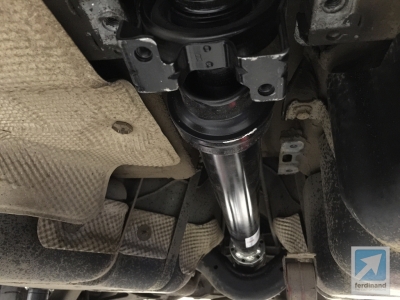
by John Glynn | Dec 12, 2014 | Porsche Cayenne, Project Cars
Not reported on my Cayenne for a little while, so that is worth an update. It’s been a busy bus and not had much love since fitting the new propshaft in September. You might remember that I bought a recon shaft and that was not right so had to send it back, then bought a new one and that had a small vibration when I fitted it.
My plan was to refit that second one using a Porsche propshaft alignment tool and then have my original shaft reconditioned by some old-school guys in Nottingham and fit that to sort it once and for all. A great plan and so far I have managed to achieve none of it! Busy, busy, busy: it may happen over Christmas.

Minor vibration notwithstanding, the Cayenne trucks on regardless. I had to top up the coolant by quite a lot for the first time in months the other day, so I guess I have a leak. As the Cayenne is approaching 140k miles, it could be water pump or could be rad wearing out. The centre coolant pipes in the V8 have been changed to aluminium, so unlikely to be that. I’ll look at it when it’s next on a lift.
It being winter, the starter has gone sluggish again, rarely starting first time from cold. I have another starter to recon and fit, but that’s another project not sorted yet. I did manage to swap the worn-out summer tyres for nice set of part-worn Pirelli Scorpion winter tyres on 19″ wheels. I like the look on the original Cayenne wheels, and the early 19s are wider than later rims. Not convinced about ultimate grip of the Scorpions but a: they are better than nothing and b: they are on the car now so we will wear them out. I’ll wash the truck when I change back to summer tyres.
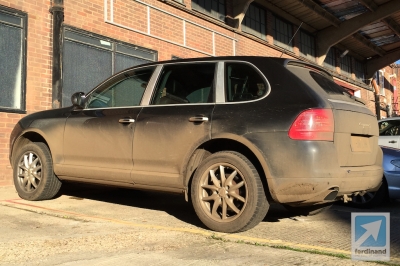
Swapping the wheels gave me a chance to to check the brakes: still looking good after plenty of miles. A big tick for lifespan of Mintex discs and pads for Cayenne. Things that will not last much longer include the rear light units – will have to replace the offside one soon as it has now started filling up with water over time. Resealing the unit made no real difference, so I drilled a few small holes in the base to let water escape. It’s had condensation problems since the day I bought it, which is common on Cayennes and very annoying.
A change to new Philips X-treme headlamp bulbs brought a lot of irate drivers on a high-speed thrash up the A34 from Portsmouth one evening. Coming up behind people quickly with my headlamps on dipped beam, the Philips pattern was obviously dazzling the car in front, but turning the headlamp beam height adjuster had zero effect on angle. Took the lamps apart the following day to find neither adjuster was working internally, so I am looking for headlamps now also: new ones are mega expensive.

Having recently used the Big Pig to tow Tuthill’s 997 R-GT rally car to a PCGB GT3 Register open day, a good friend asked me this morning what he should be paying for a used Porsche Cayenne, to do a bit of towing and usual mix of everyday work stuff. I have to confess, I pointed him towards a Landcruiser instead. He may still buy a Cayenne, but it won’t be on my say-so.
You’ll pay a bit extra up front for the Landcruiser (a proper 4.2 TD Landcruiser that is, not a 3.0 Colorado or whatever), but it comes with better reliability, better economy and better residual values. You don’t get quite as much personality, but personality is well down the list when a truck can’t hold itself together at 140k miles: small beans for a working machine. That said, I have a Landcruiser in the garage, and no plans to sell the Cayenne, so what the heck do I know! 😀

by John Glynn | Oct 29, 2014 | Project Cars, Porsche Cayenne
Anyone interested in buying a Porsche Cayenne who’s been researching their purchase via forums is forgiven for massive paranoia regarding propshaft failures. The truth is that propshaft or cardan shaft failure is going to happen to any Cayenne you buy. Propshafts or driveshafts are maintenance items on any vehicle: especially 2-tonne 4wd SUVs.
Porsche Cayenne Centre Bearing Mount
Prime suspect of a Cayenne propshaft issue is the centre bearing mount. The bearing supporting the CV joint in the middle of the two-piece propshaft is mounted in rubber. Like all rubber mountings, it eventually wears out. The vibration from a failing centre CV joint will often kill the bearing. It is under a heavy 4wd car in all weathers, so do not be surprised about this: the part cannot be expected to last indefinitely.
I just had to sort this ‘cardan shaft’ centre bearing mount failure on my Cayenne S. The centre bearing mount failed two weeks ago and I have been driving it around ever since, in the process of sorting it out to my satisfaction. If you’re easy on the throttle you can keep driving it a bit. I am now on my second shaft this week: a brand new OEM GKN Spidan propshaft.
I went a slightly long way around this issue, as the usual suppliers wanted the original prop shaft in exchange and I wanted to keep it for rebuild. I bought a recon propshaft from eBay and fitted that to the car, but as soon as I drove it it was obviously wrong. So I ordered a new shaft and fitted that last Thursday morning. I’ve got a miniscule vibration above 80 mph: more a sound than a sensation, but it still needs sorting out.
Porsche Cayenne Cardan Shaft Propshaft
My old shaft had apparently been on there for 135k miles. The car has been maintained by a Worcester specialist since 60k miles and we know they have never done it. I very much doubt that it had ever been apart: it took me ages to split the shaft off the diff input flange. In the few days I ran it with a less than perfect centre bearing mount, the centre CV joint was seizing until it warmed up, which could easily have caused the rubber mount to fail.
Taking the second (supposedly recon) propshaft off the Cayenne, no doubt the centre bearing has been replaced on this, but the centre CV joint is just like my own one: sticky and recalcitrant. The new shaft feels totally different.
Speaking to a few propshaft experts this week, all agree that the problem is tied to the centre CV joint. The complete shaft has three CV joints for maximum smoothness, but the centre one takes most abuse, is the most exposed and will eventually seize up and fail. That wears out the rubber bearing mount, but most people just swap the bearing and don’t sort the CV, which causes the same problem soon after.
Although I have a new shaft on the Cayenne now, I plan to send my old shaft to a specialist who was very helpful this week and obviously knows his stuff. He will refurbish it before balancing at the highest RPM. I plan to refit that to the vehicle in due course and see where we go from there. This is a key part of the transmission, so I want it perfect.
Cardan Shaft/Propshaft/Driveshaft
A Cardan Shaft is a propshaft is a driveshaft. The original concept to adapt ancient Chinese gimbals into a universal joint to use in transmitting power came from the Italian mathematician, Girolamo Cardano, in 1545. It’s been called a Cardan Shaft in mainland Europe since becoming common in the early 1900s. It’s a prop shaft/propellor shaft here in England, thanks to common use in the industrial revolution. A driveshaft is the same thing, normally smaller.
So, don’t think Cardan Shaft is Porsche’s fancy name for this. Cardan shaft, prop shaft, drive shaft: same thing.
Ferdinand blogs my freelance adventure with Porsche at the centre. To support the blog or engage with me in other ways, you can:

by John Glynn | Oct 22, 2014 | Classic Porsche Blog, Porsche Cayenne, Porsche News
While writing a Porsche Cayenne Buyers Guide for 911 & Porsche World magazine the other day, I came across an interesting story around the genesis of the Porsche Cayenne.
The Cayenne has long been marketed as a Porsche/VW partnership vehicle right from the start, similar to the 914, 924 and more, but the first Porsche SUV was apparently set to be based on the Mercedes ML. When Mercedes asked for shares in Porsche to cement its joint venture, the agreement between the two companies came to an abrupt end.
Porsche was already working on an SUV concept for Volkswagen, so chased the Volkswagen boss – Porsche family member and shareholder, Ferdinand Piëch – for a space alongside Wolfsburg on their posh 4×4 project. Rather than using all-Volkswagen sourced engines, Porsche’s drawing board already had Panamera sketches on it, so Stuttgart decided to build its own V8 to power the SUV plus one other. So much is down to the marketing.
Britain’s Steve Murkett led the Cayenne design team. Early reviewers felt that the reshaped front end on a van-like Touareg bodyshell didn’t communicate much style, but I disagree: I think it’s quite a stylish car nowadays and stands out from the crowd. If they didn’t know that the two were related, a casual observer would be unlikely to draw a line between Cayenne and Touareg.
As for comments that the X5 was more stylish, perhaps the market has the answer with slightly higher residuals for the Porsche. As for what we could have had – a Porsche/Mercedes ML – I am happy with things just as they are.
Porsche Cayenne Buyers Guide
Regarding the Cayenne Buyers Guide, the start points for a 2004 Porsche Cayenne S V8 like mine are quite simple.
- Check no engine ticking noises: could be coils, a failing water pump or cylinder scoring
- All gearshifts smooth and controlled: no bangs or rattles
- Check plastic coolant pipes in the V have been changed for aluminium
- Check no wandering steering – front control arms wear out fast
- No tired brakes, no past-it tyres
- No warning lights from the air suspension if fitted
- Check for damp under carpets: leaky sunroof tubes or split rear washer pipe in A-pillar
As for the rest, you’ll have to buy Porsche World next month!
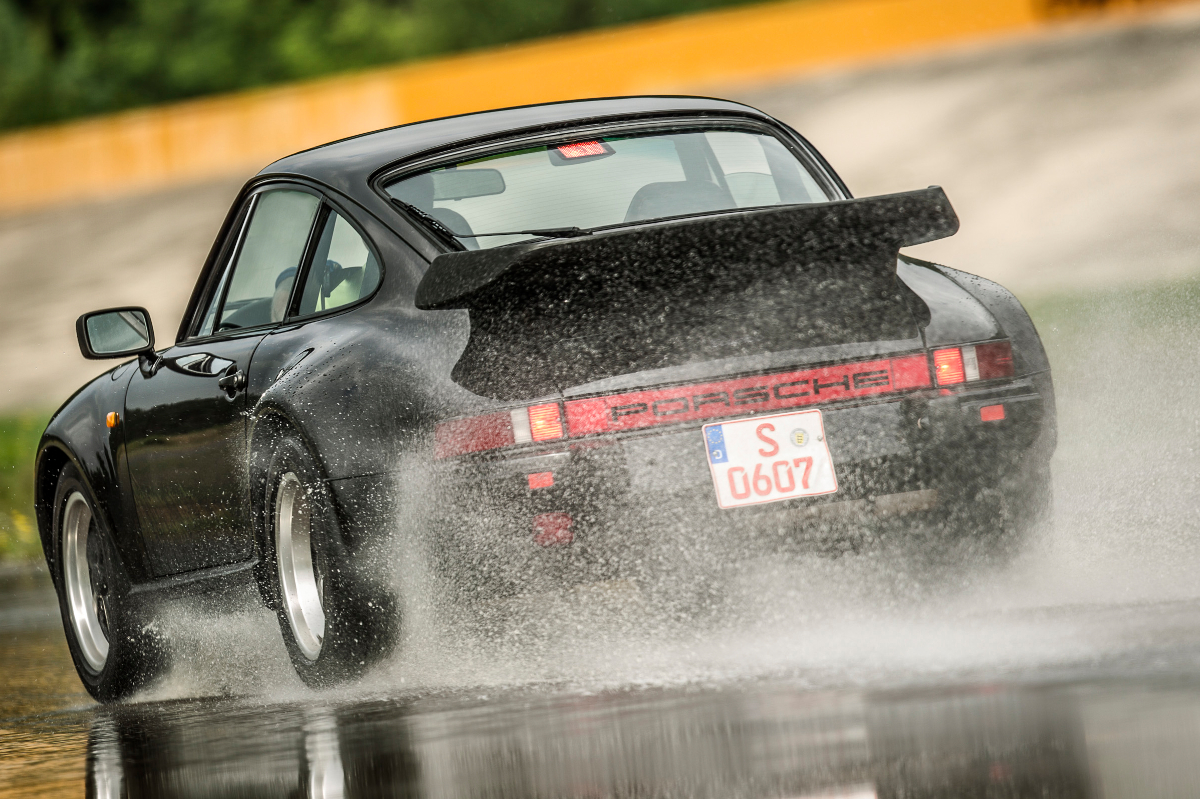
by John Glynn | Oct 15, 2014 | Classic Porsche Blog, Porsche Cayenne, Porsche News
Stuttgart recently released its latest list of Porsche approved ‘N-rated’ tyres. The approved list won’t surprise too many people, but the pic below of a Porsche 356 Coupe close to vertical on the Continental ContiDrom banking in testing might raise a smile.
Porsche’s N rating is regularly updated to keep abreast of progress made in tyre development, including tread design and compound changes. Tyre fitter legend has it that, once a tyre is granted an N rating, it cannot be altered without losing approval. The budget brands don’t feature in the Porsche lists, but is that due to money and marketing? Who believes these N-rated lists?
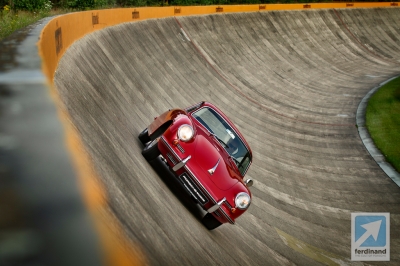
Porsche’s N rated approval lists don’t mention tyre price premiums or brand discounting on tyres supplied with new cars. Instead, the lists are said to come from extensive tests carried out by “Porsche tyre experts” over several weeks. This year, the test team used the aforementioned 356, an impact-bumper 911 2.7 Carrera, a 911 Turbo (930) and a first-gen Porsche 986 Boxster. No mention of front-engined cars or the 964/993 series with 17″ and 18″ wheels, but they do feature on the N rated lists.
The forum jury is well and truly out as to whether Porsche-approved tyres are that much better than non N-rated tyres. I have used both N-rated and unrated tyres on my own classic Porsche cars and been happy with examples from each camp. That said, my 911 is currently on non N-rated tyres that do have a version on the Porsche approved list and they have proved excellent. I am not saying that the N rated list is fallacy, just that there are other tyres out there that seem to work well on older Porsches.
N rated Porsche Tyre Prices
A set of new N-rated tyres for my 911 costs around £400, so it’s not saving a huge amount of money over five years (or however long you expect tyres to last on a car doing 2k miles a year) to pick a set of tyres costing a hundred quid less. Not that I ever buy new tyres for my own cars, and the argument changes if you use your Porsche daily: Ferdinand’s 10 year-old Cayenne S will happily demolish two sets of part-worn Continental tyres in ten thousand miles.

I started my classic Porsche career on Kumho tyres, and have also used Falken, Goodyear Eagle F1, Michelin Pilot Sport Cup and Continental ContiSportContact to name a few I recall. Friends use Bridgestone S-02 (approved), S-03 and Toyo R888 on track cars. I like driving on the Bridgestone S-02s but find the 888s to be very noisy and hard work in heavy rain. I’ve driven too many 911s on Michelin TB5 and TB15 to list: not my favourite tyres but they do look good on wide wheels.
My own preference thus far is for Pilot Sport Cups, but ignore what I am telling you. They are super expensive, will scare you a bit in torrential downpours and won’t last more than 2,000 miles if you’re lucky. That said they look drop-dead gorgeous and the grip is amazing. My last set of Pilot Sport Cup rubber expired about four years ago and I’ve been on ContiSportContact ever since: grip is great, long tyre life (as I don’t go anywhere) and superb in the wet.

N-Rated Tyres on Classic Porsche Cars
ContiSportContact and SportContact 2 are N rated tyres. The SportContact is also an F-rated tyre: Ferdinand recommends them 100% based on the fact that we’ve used SportContacts for more than 5k miles and didn’t die in a blazing inferno due to skidding off-piste. ContiSport Contact 3 is not N rated but they are also great: been using them on my E36 BMW M3 for a couple of years and they are superb, but not N rated and not available in 245/45 16 to fit 9″ Fuchs. Both sets of SportContact rubber replaced GoodYear Eagle F1s, which must be the worst tyres I have ever driven on: Kumhos included.
The Porsche N rated tyre lists include approval for:
- Porsche 356: Pirelli P6000 (would not look great IMO)
- Porsche 924: P6000, Continental ContisportContact and Michelin Pilot Exalto PE2 (I have P6000s on my 924 Turbo)
- Porsche 928: Pirelli P Zero Asimmetrico, ContiSportContact, Michelin Pilot Sport PS2
- Porsche 959: Bridgestone RE71
- Porsche 964: Pirelli P Zero Rosso, Bridgestone S-01, Bridgestone S-02A
- Porsche 986 and 996 add ContiSportContact 2 and Pirelli P Zero Direzionale.
I’d be interested to know who is using non N rated and how they have been doing – add thoughts in the comments. Anyone who believes Porsche cars should only run on N-rated rubber can rest assured that we understand the arguments in favour but are happy to deviate from that advice.

by John Glynn | Sep 27, 2014 | Porsche Cayenne, Project Cars
I drive my Cayenne S as the makers intended, which frequently means doing fairly high speeds while approaching roundabouts, junctions and the rest. You sit high in the Cayenne, but the PCM radio screen position is low in the dash, under the dash vents. So checking the sat nav display on the head unit could be dangerous in the wrong situation.
It’s not a huge issue if you retain PCM, as the display in the centre of the clocks gives arrow indications of directions ahead, and Cayenne models later than my 955 have a beautiful multi-colour sat nav screen to play with. However, PCM does not readily integrate iPod/iPhone music support, or postcode navigation, or Bluetooth for phones, or DAB radio. I wanted all of these, so I upgraded/updated the PCM 2 supplied with my Cayenne as standard and fitted the Kenwood DNX4210DAB instead.

With iPhone control, superb Garmin navigation, DAB+, 3 2v RCA preouts and an interface for the multifunction steering wheel controls, the 4210DAB has proved almost perfect to use. But by switching to an aftermarket unit, I’ve lost my dash direction display, and frequently find myself looking down by the gear lever to check my GPS speed, position and route ahead. I don’t like this on unfamiliar roads, and definitely would not be a fan on foreign motorway journeys, a few of which are already pencilled for next year.

So I’ve sold the Kenwood 4210 and replaced it with a Kenwood DDX4025DAB: has all the same features as the 4210 including DVD player and so on but without the navigation. The screen is not quite as nice, but the sound is great. I am looking at ways to integrate my separate Garmin 2595LM navigation unit into the dashtop or add one of the latest head-up displays for smartphone GPS navigation into the Cayenne.

I’ve recently picked up an iPhone 6 Plus 128GB, so it could be that this with the Garmin iPhone app and a head-up link is the way forward for my in-car navigation. Would be interested to hear from anyone using head-up displays in their car. It looks to me like the 955 Cayenne dash will not allow head-up directly in front of the driver due to the screen angle and depth of the dash binnacle, but I am going to see what I can get my hands on to try out. It’s pretty easy to get used Cayenne dashboard parts on eBay to cut up for trial fit.
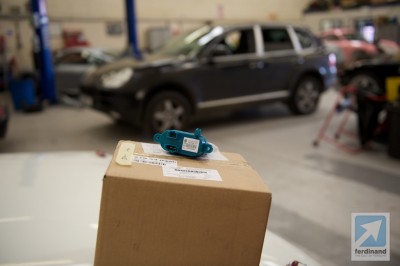
by John Glynn | Jul 20, 2014 | Porsche Cayenne, Project Cars
“What’s that smell, dad?” asked youngest daughter as our Porsche Cayenne stormed away from a t-junction on a recent morning school run. The odour seemed familiar, but took a few hours to recall out what it was.

At first I thought the acrid, slightly burnt aroma was from the car in front, but when I heard the heater fan seizing up as I arrived in a car park later that morning, I remembered the smell when my 911 blower fan failed in the south of France on the 2010 R Gruppe Bergmeister Tour. Same thing.
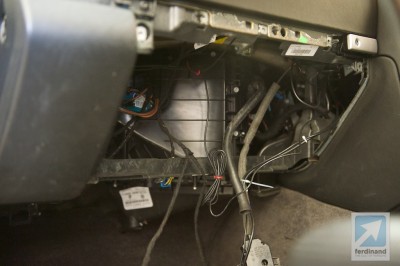
The Porsche Cayenne is known for blower fan failure. These cars are big inside, with only one fan controlling the climate, so of course the fan is going to need replacement at some stage. I’d known it was getting weak for a while, but not been too anxious to change the fan as it’s a Porsche-only item and suitably priced. Now it was time to sort it out.

Some people spend hours repairing the heater fans (with unknown reliability), but that’s messing around I haven’t got time for. Chris at JZM recommended changing the heater blower resistor at the same time as, having been under increased current draw for such a long time, these usually fail soon after the blower fan is replaced. There speaks the voice of experience.

Once the parts were in stock, I set a Saturday morning aside to fit the new fan. Fitting the fan was easy: take out the glovebox, undo the wiring and seven hex screws, swap the fan over and put it all back together. The resistor is two screws and right in front of you when the glovebox is out: it’s a Volkswagen part, of course.

With the new fan fitted, the Cayenne is now cool & composed inside. Total cost was something like £300, but I’ve yet to see the parts bill. It’s a small price to pay for the pleasure and comfort with outside temps topping thirty degrees C ambient this year.
My next problem is a water leak: small but enough to annoy me at circa 750mls in 5k miles. The coolant pipes have already been done, so my first port of call will be checking the water pump. The Cayenne is due an oil change anyway, so we’ll have a look when that gets done.





